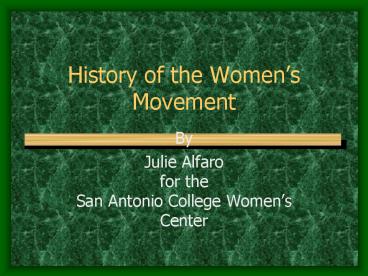History of the Womens Movement - PowerPoint PPT Presentation
1 / 16
Title:
History of the Womens Movement
Description:
July 13, 1848 marks the beginning of the Women's Right Movement. ... Two days later the women planned the Seneca Falls Women's Convention. ... – PowerPoint PPT presentation
Number of Views:174
Avg rating:3.0/5.0
Title: History of the Womens Movement
1
History of the Womens Movement
- By
- Julie Alfarofor the San Antonio College Womens
Center
2
150 Years of Change
- 1998 marked the 150 year anniversary for women to
achieve full civil rights - Changes in family life, religion, government,
employment, education - Seven generations of women have democratically
sponsored meetings, petition drives, lobbying,
public speaking and nonviolent resistance.
3
A Revolutionary Tea
- July 13, 1848 marks the beginning of the Womens
Right Movement. - Elizabeth Cady Stanton and her fiends had tea and
discussed the plight of women. - Two days later the women planned the Seneca
Falls Women's Convention.
4
A Declaration of Sentiments
- We hold these truths to be self-evident that all
men and women are created equalthat they are
endowed by their creator with certain
inalienable rights - Stanton listed eighteen grievances.
5
The First Womens Convention
- The Declaration of Sentiments ended on a note of
complete realism "In entering upon the great
work before us, we anticipate no small amount of
misconception, misrepresentation, and ridicule
but we shall use every instrumentality within our
power to effect our object. We shall employ
agents, circulate tracts, petition the State and
national Legislatures, and endeavor to enlist the
pulpit and the press in our behalf. We hope this
Convention will be followed by a series of
Conventions, embracing every part of the
country.
6
Backlash
- Newspaper editors ridiculed the women and often
publish the Declaration of Sentiments. - Some women were so embarrassed that they had
their names removed from the declaration. - The right to vote, the ninth resolution, was
especially targeted!
7
The Growing Movement
- The movement began to spread as a series of
conventions followed. - Elizabeth Cady Stanton, Susan Anthony, Lucy Stone
and Sojourner Truth lectured through out the
country. - This movement had so much opposition that it took
72 years to achieve success-the right to vote.
8
The Nineteenth Amendment
- After the right to vote was achieved, some women
realized that the quest for equality was not
over. - League of Women Voters
- National Womens Party drafts ERA
- The Birth Control Movement began just as the
suffrage movement ended. - Birth control was considered obscene until 1965.
9
The Second Tidal Wave 1960s
- Esther Peterson, director of the Womens Bureau
of the Dept. of Labor in 1961, worked with John
F. Kennedy in forming the Commission on the
Status of Women.
- Betty Friedan published The Feminine Mystique in
1963. - Title VII of the Civil Rights Act of 1964 passed
which prohibited employment discrimination on the
basis of sex
10
The Second Tidal Wave
- The EEOC is formed to investigate discrimination
complaints. - NOW formed when the EEOC was complacent in
investigating.
- Other organizations formed to address issues
specific to certain groups or ethnicities. - College women began the Womens Liberation
Movement as a result of their efforts to take
leadership roles in the anti-war and civil rights
movements dominated by men.
11
New Issues
- The combining forces of women produced a wide
array of services, clinics and centers aimed at
helping women become self-sufficient in all
aspects of life.
- Title IX in 1972 the number of women in higher
education and to professional schools increased. - 25 years ago, 1 in 25 women played sports today
the number is 1 in 3.
12
New Issues
13
ERA Re-Introduced
- In 1972, opponents argued that the the ERA would
lead to family abandonment, unisex toilets, gay
marriages, drafted women.
- It failed to receive ratification in 38 states.
- Only 46 supported equal rights for women.
14
More Issues and the Third Wave
15
The Future
- In 1971 only 3 of women held congressional
seats. - Today, 11 of women hold congressional seats
- Today, 21 of women hold state legislative seats.
- Today, more than three million women hold
nontraditional jobs.
16
The National Women's History Project3345
Industrial Dr. Suite 3Santa Rosa, CA 95403
- As Alice Stone said, I always feel the movement
is sort of a mosaic. Each of us puts in one
little stone, and then you get a great mosaic at
the end."































![get⚡[PDF]❤ THE FORGOTTEN HEROES: The Untold Stories of Women in Politics and Activism PowerPoint PPT Presentation](https://s3.amazonaws.com/images.powershow.com/10050328.th0.jpg?_=20240607114)